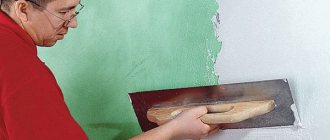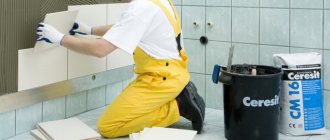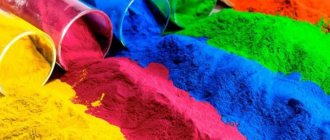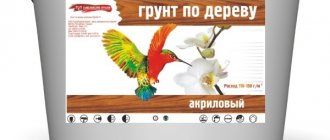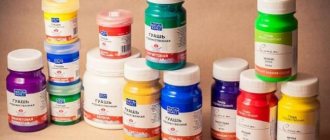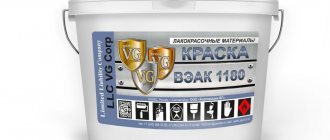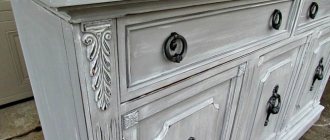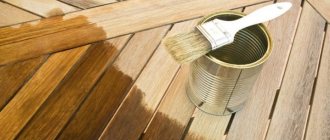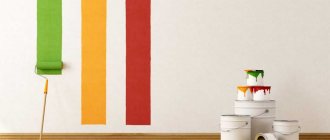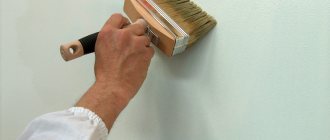What it is
A color for water-based paint is a concentrated mixture of pigment based on the binder composition of one of the shades. The purpose of the color is to give the paint the required shade.
Today, manufacturers offer a huge range of pigmenting compositions in a wide variety of colors. However, choosing the right color for a water-based emulsion is not so easy.
The purpose of the color is to give the paint the required shade.
Varieties of colors
Before you go shopping for color, pay attention to the existing types of this product.
The coloring matter is distinguished by the composition of its components, by the form of release and by the area of application. Based on their composition, there are several types of colors:
With pigments of organic origin. This type of color scheme has a richer and wider range of colors. Due to its origin, paint painted with organic colors quickly fades when exposed to sunlight, so it is not recommended for painting facades.
With pigments of inorganic origin. The choice of colors for this color scheme is much scarcer, but this pigment is resistant to destructive factors, including sunlight.
According to the release form:
- Color in the form of paint.
- Color in the form of dry powder.
- Color in paste form.
They are classified according to the area of application:
- A universal color is a substance that can be mixed with any paint.
- Highly specialized color - this pigment is produced differently for each type of paint.
Tinting functions of water-based dye
It is not always possible to find paint of the desired tone; in this case, the most optimal solution would be to give the paint product a suitable color. In order to make tinting, it is enough to purchase pigment and gradually add it to the paint to achieve the necessary color saturation. Thus, you can create a unique interior.
In order to make tinting, it is enough to purchase pigment and gradually add it to the paint to achieve the necessary color saturation.
How to achieve the desired color for different types of emulsion
The most commonly chosen paint for walls and ceilings in the house is water-based. It is easy to apply. By adding pigment to it, you can achieve a variety of shades that cannot be found in finished form. However, not everyone knows that water-based paint is available in several types. Depending on the type of polymer used in the preparation of the base composition, acrylic, mineral, silicate and silicone compositions are distinguished. The color for water-based paint is selected on a water basis, since it is compatible with all presented compositions.
You can most often find acrylic paint on store shelves. It is presented in a wide range and is very popular due to the price-quality ratio. Paint is produced from acrylic resins and a number of additives that give the paint certain properties. So, for example, latex allows you to use acrylic paint in damp rooms because it repels water. The color for acrylic paint is universal, which allows you to use the resulting mixture for painting any surface. The paint dries quickly enough, which reduces repair work.
Water-based color compatible with all types of water-based paint
A more expensive option for water-based paint is silicone-based paint. It is suitable for painting surfaces in damp rooms, but does not create a vapor-proof film, but allows the surface to breathe. Water-based paint with the addition of liquid glass gives the surface an important property - it absorbs excess moisture and returns it back when the air is dry. After tinting, such paint is excellent for use outdoors, as it withstands all weather conditions; however, unfortunately, it is not recommended to use it in rooms with constantly high humidity.
If you plan to paint surfaces such as concrete, brick and plaster, then it’s time to use a mineral water-based emulsion. It contains slaked lime or cement, which allows the paint to withstand moisture, chemically aggressive environments and ultraviolet radiation. The most common color for water-based paint based on mineral additives is used. And you can prepare the desired shade either by machine or by hand.
Colors
It will be easier to correctly navigate the colors when choosing the appropriate shade if you use a paper color chart. Of the maximum number of different colorants with different color palettes from soft beige to coffee, from peach brown, from gray to pearlescent and with sparkles, the most popular are shades of primary colors or contrasting options, for example, a combination of black and white, green and red, yellow with blue. Recently, golden, silver, light green and pistachio colors have been in fashion.
It will be easier to correctly navigate the colors when choosing the appropriate shade if you use a paper color chart.
Types of colors
Colors are made based on organic and synthetic substances. The palette of fillers of the first type is wider. But the pigments they contain gradually become discolored under the influence of ultraviolet rays.
Synthetic colors are more stable and retain their color brightness for a long time. Therefore, they are added to façade paints and other exterior coatings.
Based on consistency, paint fillers are:
- dry;
- liquid;
- pasty.
Dry ones are diluted and then combined with base paint. For example, if you need to add color to an oil base, it is first combined with drying oil.
Liquid fillers are available in the form of ready-made additives, combined with different types of paints.
Paste-like fillers are available for enamels and varnishes, acrylic and water-based paints, etc. Universal options are also available, suitable for different bases.
To obtain pastel shades, dry filler is added to the white base paint. Rich colors are obtained by mixing with liquid or paste components. The saturation of the paint is easy to adjust. But it may change when applied to the surface or after drying.
Types of colors by consistency
Consumption
Many people are interested in how much color is needed for 10 liters of paint? Using a tinting card, you can not only select the desired shade, but also calculate the consumption of the tinting mixture per 1 kg of paint and varnish.
Color consumption for white paint depending on its type:
- For a water-soluble paint and varnish, the amount of color should not exceed 1/5;
- To tint oil paint you will need 1-2% of the mixture;
- Other types of coloring compositions will require no more than 4-6% pigment.
Even to create a rich color, you should not exceed the pigment consumption, so as not to deteriorate the paint.
Even to create a rich color, you should not exceed the pigment consumption, so as not to deteriorate the paint.
What is paint color?
The word “kohler” is translated from the Latin “color” as color or tone. In the chemical industry, color is a special highly concentrated pigment composition with which you can obtain almost any shade of paint. Moreover, not only water-based products, but also façade, oil, and acrylic products can act as a base. Depending on the concentration of such pigment composition in the paint, you can achieve both rich and bright colors and muted, pastel shades.
What is it needed for
The use of color helps property owners turn almost any design idea into reality. The process of mixing and diluting paint and varnish material with pigment is called tinting. Its use is suitable not only for finishing work inside the building, but also outside it. Using a special pigment solution, you can obtain unique shades, for example, the paint can be given a copper, pearlescent, bronze, or golden hue.
The color can be used on concrete, brick, plastered walls. Other surfaces can also be treated with compositions using it: plasterboard, wood, fiberboard, chipboard. The use of tinting is necessary in the following cases:
- the original layer has minor defects;
- you need to choose a shade in accordance with the color scheme of the interior;
- you need to decorate the interior using several shades of one or more colors;
- you need to correct errors that occurred when calculating the volume of paint or the absence of a color used previously.
Kinds
- With organic pigments. Products of this type are distinguished by a more saturated range of colors, but the paints and varnishes obtained from them lose their brightness and saturation over time due to exposure to sunlight. For this reason, compositions with pigments of organic origin are considered not the best choice for facade paints.
- With inorganic pigments. Such products are more resistant to aggressive external factors, including burnout. True, this paint color cannot boast a wide range of shades.
Rules for tinting
You can tint the paint manually or computer-aided. Thanks to the first option, you can save a significant amount of money and perform the procedure directly at the repair site. There is also a drawback: it is almost impossible to reproduce exactly the same tone again. The second type of tinting is controlled through a special program. The operator only needs to select the color scheme, and the program itself will determine the proportions, after which it will produce the finished composition.
When deciding to dilute the pigment yourself, consider the technique:
- Decide on the required amount of color. It is better to initially buy more than to look for identical products later.
- It is recommended to select a color for painting surfaces by making a sample. To do this, fill a small container with 100 mg of white paint and add a few drops of pigment to it. By mixing, obtain the desired shade.
- Check how the resulting composition looks on the wall or other surface that needs to be painted. The color of the finished solution does not always match the shade of the paint and varnish material applied to the wall. The result should be viewed under the lighting prevailing in the room (artificial or natural), after the composition has dried.
- If you know how many drops you had to add to get the desired color, then by recalculating the consumption of the composition per liter of paint, you can dilute and get the required amount of color.
- The pigment composition should be added to the paint and varnish material in a thin stream. At the same time, do not forget to mix everything thoroughly to obtain a concentrated composition with a uniform color.
How to choose
When choosing a color for water-based paint, you should pay attention to the following nuances:
- It is necessary to select taking into account the texture of the surface that will be painted, otherwise the result may be disappointing. You should also consider tones not only in electric, but also in natural light;
- You must immediately calculate the required amount of color mixture per 1 kg of paint, otherwise, due to a lack of color, you will have to select another one;
- The tinting concentrate must be chosen from one manufacturer, otherwise different brands of the same color may look different;
- A container with a narrow neck will provide a convenient and economical dosage, so the pigment can be diluted by simply dripping it into the paint. Because if you add more pigment than normal, the color will turn out brighter and darker than necessary;
- In addition, you need to pay attention to the paint, it should only be white, otherwise the yellowish material will give a beige tint when tinted with peach pigment.
You need to pay attention to the paint, it should only be white.
Definition of color and its application
The color can be used as one color or combine several pigments at once to obtain a more complex and unique shade. It contains various pigments and additional elements that give greater color saturation and durability; it also contains water and resins. Color is added to paint to achieve a special color that is different from the regular color.
The concentration of this color in the tinting agent is higher than that of the desired shade, so when mixed with paint, the main shade becomes more diluted and becomes better suited for painting.
The composition may include inorganic and organic substances that affect the quality of the coloring material, its brightness and the time the resulting color remains after dyeing.
Color selection methods
The coloring pigment is needed for mixing with white enamels, plaster, and decorative putty. Used for adding to water-dispersion compositions and alkyd coloring elements.
To achieve the desired color, two tables are used at once:
- RAL - it is designed for 210 tones;
- NCS - designed for 1950 shades.
Such scale tables help you choose the right shade easily and quickly.
Manufacturers may use their own methods for grading colors, but you must know in advance what color you need. The selection of shade is carried out by comparing the shade with the general color of the walls. It is necessary to pay attention to the fact that it is unrealistic to achieve the same effect when mixing the tonal composition independently.
This is due to the impossibility of determining the amount of paint in a container down to a whole gram. Due to the strong saturation of the tinting mixture, the color of the resulting tone can be greatly changed even with a slight deviation from the resulting color.
With the manual mixing method, it is best to calculate the volume of the dye so that one mixing is completely enough to cover the entire surface of the part to be painted. In this case, it is imperative to increase the amount of coloring pigment consumption by twenty percent so that there is definitely enough for painting.
During work, you can use dispensers to add the desired tone to the paint, and to obtain a better finish, you can use drills to thoroughly mix the coloring matter.
What is needed for tinting
For independent tinting you will need:
- Roller;
- Brush;
- Construction mixer;
- Paint tray.
For machine tinting you will need the following equipment:
- Stand with a catalog and shade table;
- Fan of shades;
- Computer color equipment for selecting a coloring composition according to a specified sample;
- Dispenser.
For self-tinting you will need special tools.
Classification of water-based dye by composition
Since the pigment for water emulsion includes all kinds of additives, the colors are divided according to the additional components. Thus, the classification of water-based dye is as follows:
- Organic composition of the dye;
- Pigment composition based on artificial additives;
- Mixed composition of organic and artificial components.
Since the pigment for water emulsion includes all kinds of additives, the colors are divided according to the additional components.
Classification of colors
The consistency of colors of paints and varnishes can be divided into the following types:
- pigment products in liquid form - added to water-dispersion and water-emulsion coloring materials;
- liquid pigments or pigment pastes - for coloring soil mixtures, impregnations, varnishes that are used to coat wood;
- pastes, liquid-type tinting mixtures - added to oil-based coloring mixtures and alkyd products, to compositions used for whitewashing;
- pigment materials that have a matte or shiny finish are good for decorating paints and varnishes;
- universal tinting pastes - added to enamels with organosilicon, polyurethane and hydrocellulose, as well as epoxy compositions.
Coloring paste is divided into two types - façade and universal. The characteristics of each dye will be determined in accordance with the presence of organic and inorganic pigments in the composition.
Algorithm for adding color
Obtaining a high-quality result is possible only if the rules of tinting are followed. Sequencing:
- The required amount of paint is poured into the tray.
- The bottle of paste is shaken and the pigment is added in the indicated proportions.
- Mix the mixture thoroughly using a mixer. The resulting solution is tested.
- Immediately before painting, you need to mix everything thoroughly again so that there is no sediment.
Obtaining a high-quality result is possible only if the rules of tinting are followed.
How to choose?
"SkidkaGID" in Moscow presents video reviews on the topic of optimal choice.
id=85875
How to paint the walls? Something that would be washable and environmentally friendly!!!
Color paste UNIVERSAL No. 08 red-brown (TEX), 0.1 l review 19041
Basic paints: types, features, tinting
Tips from TC “Kashirsky Dvor”: How to choose facade paint
How to repaint walls during renovation
YouTube Terms of Use / Google Privacy
Manual mixing
The manual method involves mixing pigment and paint yourself, at home, based on the manufacturer’s recommendations. The advantages of hand tinting paint include:
- Financial savings;
- The paint color can be diluted at the repair site;
- You can create unique color schemes.
However, this method has a disadvantage: it is impossible to recreate the resulting shade.
The manual method involves mixing pigment and paint yourself, at home, based on the manufacturer’s recommendations.
Mixing Methods
The tinting process is divided into two methods : manual mixing process and computer painting. The second method helps to obtain the desired tone, which can be used later when saved in a special program. When carrying out manual tinting, a new shade will be obtained each time.
Manual mixing
Tinting paints requires the user to have a base tone and a special coloring component. Coloring pigment should be added before starting work. It is best to follow the rules and proportions that are noted in the instructions for the paint.
The independent tinting process has several advantages:
- beneficial cost savings;
- can be used and diluted during repairs;
- you can create a unique and unrepeatable overall tone that will have no analogues.
Before you start tinting the paint, you need to remember that when mixing by hand, it is simply impossible to get the same shade again.
Computer operation
Machine tinting is carried out using a special computer program. Advantages of computer tinting:
- Time saving;
- You can easily reproduce any color again;
- Extensive selection of shades.
Machine tinting is carried out using a special computer program.
What to consider
With the help of tint, you can give the desired color to wooden, concrete, brick, metal surfaces, as well as plaster and drywall, both indoors and on the façade base. The desired shade is achieved by dosing the pigment.
The color can be diluted in water-based, oil-based, alkyd, acrylic, epoxy paint, and nitrocellulose and polyurethane foam products. It is best to select a shade using a tinting table, following the instructions in the manufacturer's instructions. The best solution would be to purchase paint and pigment of the same brand.
If the concentrated dye is not completely used, then you need to add a little water to it, so it will be stored for 5 years.
The best solution would be to purchase paint and pigment of the same brand.
Brands of colors
Each paint manufacturer produces its own line of pigments. The best solution would be to buy paint and tint from the same brand. This combination (subject to the manufacturer's recommendations indicated on the packaging) gives a good result. The color will be closest to the one stated in the palette. When using materials of different brands, the mixture may have a non-uniform structure, and the shade may be unpredictable. But if desired, the buyer can experiment and create his own range.
Getting your own color
To give the paint the desired color, you do not need special equipment or special skills. However, you must adhere to the rule of manual mixing, use as much colorant as required to paint the room, otherwise, if there is not enough paint, you will not be able to achieve the desired tone again.
Only white paint in the required quantity is poured into the tray and the amount of pigment specified in the instructions is measured. Next, the mixture is stirred with a drill and mixer. The colorant is added gradually, first 2-3 drops, after that you need to look at the color, if it suits you, then the paint is stirred at minimum speed or a little more pigment is added, and the steps are repeated until the result is obtained.
Only white paint in the required quantity is poured into the tray and the amount of pigment specified in the instructions is measured.
"Recipes" of the most popular shades
Now in the interiors of modern homes, you can find the most varied and boldest shades. It happens sometimes - you look at a color and think, how did you get it? Let us give an example of the most noble shades and their composition in percentage:
- Royal red – add 5-10% cool blue to a cold red base. You can experiment with the same content, but with warm colors;
- Tomato red - easy to get by adding 5% yellow and 5% brown to the base red;
- Raspberry - its base has a blue color, to which 1-2% of white, brown and red are added. If the intensity is insufficient, add again a small amount of auxiliary colors in equal parts;
- Olive - 10-20% yellow is dissolved in a green base, depending on the desired saturation;
- Turquoise green - add no more than 20% blue to the standard green base;
- Bottle green - obtained by mixing yellow and 20-40% blue;
- Turquoise blue - easy to get by adding 10-15% green to the standard blue color;
- Royal blue - this chic shade is obtained by adding 10-15% black and 2% green to a blue base;
- Saturated dark blue - obtained by adding 5% black and 2% green to the blue color;
- Golden brown - for a shimmery effect, add 10% blue, 10% white, 10% red to yellow. At the same time, the higher the percentage of yellow base, the higher the contrast;
- Mustard - to the yellow base you need to add 5% black, 5% red, 1-2% green;
- Noble pink-gray color - obtained by adding up to 5% black and up to 5% red to white;
- Gray-blue tint - obtained by adding 5% light gray and 1% blue to a white base. With the same proportions, but with the addition of green instead of blue, they will give a gray-green tint;
- Lemon yellow - a bright and positive color is obtained by adding 5% white and 1-2% green to standard yellow. Moreover, if the base yellow is of a warm shade, then the final color will be more yellowish;
- Sea wave color - can be obtained by adding 35%, no more, green and 5% black to white paint;
- Royal purple - obtained by adding small quantities and equal proportions of black and blue to a red base until the desired level of saturation is achieved;
- Burgundy – add 5 to 10% of each color to the red base, but in equal parts – yellow + brown + black;
- Plum is a wonderful shade obtained by adding 10% black, 10% blue and 5% white to a red base.
All of the above is a clear example of the glaze process. After which the resulting shade can be used either as an independent composition, or as a color, which is usually diluted in a white base.
Coloring on a professional device
Using computer tinting, you can ensure that white paint acquires the desired shade in a short period of time, which is especially important if a large volume of paint and varnish is used. Using a color chart will greatly simplify the process. In addition, if necessary, the desired color can be repeated exactly. However, this method cannot obtain results at the repair site. In addition, it is impossible to create a unique color scheme by machine.
The tinting system consists of white paint, pigment, dispenser, construction shaker and computer program. The entire work process is carried out automatically.
Using computer tinting, you can ensure that white paint acquires the desired shade in a short period of time.
Coloring technology
Before tinting the paint, you need to calculate the color consumption, select the tone and prepare the necessary tools. Of course, if you do it at home. To make the work easier, specialists have created a special tinting table, thanks to which you will know how to properly dilute the pigment and in what ratio. But you need to understand that it is quite arbitrary, and the proportion may differ depending on the paints and components used.
Rules for calculating colors
To correctly calculate the ratio, it is necessary to subtract a fifth from the amount of pigment. As an example, we can consider a color that is as close as possible to sea wave. To obtain this shade, you need to add blue and green colors to the white paint. For example, 200 ml of paint uses 10 drops of blue pigment and only 4 drops of green. To calculate the consumption per 5 kg of paint, you accordingly increase the amount of pigment by multiplying. As a result, we get: 250 drops of blue and 100 drops of green.
Mixing components - step-by-step instructions
- Prepare several small containers. Remember, they must be perfectly clean.
- Pour in the components to be tinted and be sure to record the quantities of ingredients.
- Apply a small amount of the resulting paint to the surface that needs to be painted later.
- Let it dry.
- If necessary, apply another coat.
- Color assessment is carried out only in daylight and after complete drying.
- Once you have achieved the desired shade, you can begin tinting the entire mass of paint.
- For a large area of painting, you will need many containers or one, but large one. If you use 3-4 small containers, then pour paint into it in exactly the same amount.
- Wash the containers, wipe thoroughly and dry. Even the presence of dust should not be allowed.
- Mix the laid out paint with a wooden stick and begin to gradually add color. Mix with a piece of wood first, then use an electric drill with a mixing attachment. This will ensure uniformity.
- Next, you can paint the surface.
Review of the most popular colors
Today the construction market is simply overflowing with various coloring pigments of any type and manufacturer. The following are considered the most popular and in demand among foreign and domestic pigments:
- "Tikkurila Symphony" is used for tinting Tikkurila paint. It has a wide range of shades (2256), up to 10 only white. Used for interior finishing work. But for domestic customers, the company of the same name produces the Tikkurila Facade pigment. There are also options for adding color to antiseptics and varnishes.
- Natural Color System (NCS) is produced according to Swedish and Norwegian standards. This system has 6 primary (base) colors and many shades. Thus, it turns out that the basic shades are qualified by letter designations, and the percentage of the main color in the color scheme is qualified by numbers.
- "Tex" is produced specifically for water-dispersed dyes. It is of high quality, despite the fact that it is a domestic product. Manufactured from imported active pigments using German equipment.
- "Aqua-Color" is produced in St. Petersburg. It is distinguished by versatility, high quality and a wide range of shades. Used for all paints and finishing works.
- The company produces Unicolor paint. Intended for many types of LKS.
- The Moscow Rogneda factory produces Dali coloring pigments. It is also of high quality, used for enamels, whitewash, and water-based paints. Can be used for all surfaces.
Read about how to tint acrylic paint in the special material on our website.
Useful tips
Before starting work, it is necessary to carry out a test mixing, which is carried out as follows: take a 100 ml container, pour paint into it, then add 1-2 drops of pigment and stir the mixture, if you need a more saturated color, you can add another color, 1 drop at a time, until You won't get the right tone. Number of drops per 100 ml. paint is recorded and the required amount of color is calculated for the entire volume of the room. When using several colors, you need to use a tinting table.
Before painting the walls, you need to paint a small area, wait until it dries to make sure that the desired result is achieved. To prepare mixtures in large volumes, 20% is subtracted from the estimated volume of pigment, because the color looks brighter over a large area.
Before painting the walls, you need to paint a small area, wait until it dries to make sure that the desired result is achieved.
By taking seriously the recommendations of specialists, you can independently achieve the desired color, which is not available in any store. At the same time, it is important to remember that you can and should experiment, but within reasonable limits, so it is important not to exceed the color norm so as not to spoil everything.
Types of colors, how to choose, how to dilute and how to choose a color
Color is added to the paint to give it a color that matches the style of the room.
Types of pastes are divided into:
The second ones on the list have bright tones. At the same time, the choice of color palette is quite large. But, despite this advantage, there is one drawback - they quickly fade when exposed to sunlight.
Inorganic pigments are produced in limited quantities; their colors are dull, but they retain their color properties for a long time.
How to choose a color for painting walls? To do this you need to do the following:
Explore the proposed catalog. In the absence of a color code, it is not necessary to experiment with obtaining a tone in a store, since the color obtained in this way will differ from the one created in everyday conditions. The color must be mixed with a small portion of the color base. When lighting a room artificially, it is recommended to use organic pigments, and when natural color predominates, inorganic ones. Products from a foreign manufacturer are not necessarily better than domestic ones
Russian manufacturers produce tinting pastes of no less quality than the products of their foreign colleagues. You should pay attention to the neck of the bottle, it should be narrow, this will make dosing easier. A palette of water-based paints will not be superfluous when purchasing diluted pigment, it will be easier to navigate in order to get the expected shade.
- Tikkririla. The products of this company are designed to obtain the expected result after initial dilution with the base. In total there are more than 2000 tones from this manufacturer. The manufacturer offers a choice of a number of shades for painting facades.
- Natural Color System (NCS) - the color is made according to the standards of Swedish and Norwegian manufacturers. There are only 6 primary colors in the range: yellow, black, red, green, blue and white. Other tones are derivatives of them. Based on the letters and numbers printed on the containers, it is easy to decide on the choice of color.
- Tex is a company that produces pastes based on pigments produced outside the Russian Federation.
They are versatile and are used to add color to water-based paints, putties and added to whitewash. Used for interior work and painting facades. - Rogneda is a network of Moscow organizations that produces products for artistic purposes and adding tone to paint, plaster or putty. The color of this company is resistant to exposure to the sun and negative temperatures, and also has high adhesion properties.
- Elakr is a color for façade paint. It is resistant to negative environmental factors and resistant to light. Ideally stored at sub-zero temperatures. Most façade paints are produced on a white base and require diluting to give them color.
Is the color white or not? Basically, the manufacturer produces colored pastes in light and rich colors, but in some cases there is also a white color. It is typically used to provide weather resistance and abrasion protection for advertising lettering and graphics.
